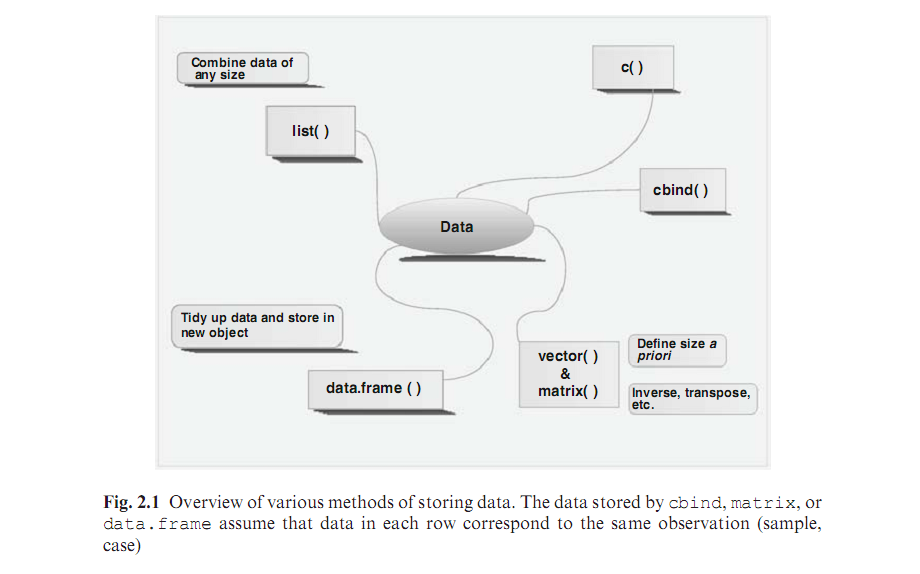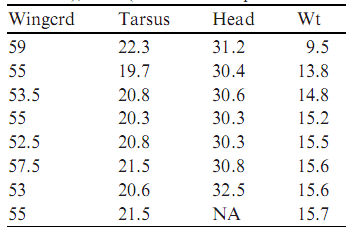FES 720 Introduction to R
Working with Data in R
FES 720: Intro to R

A. Types of Data

B. Getting Data into R
There are various ways to import data into R.
- Entering data by hand
- Entering data with
c() - Combining variables:
c(),cbind(),rbind() - Functions
vector(),matrix(),list(),data.frame() - But better to enter it outside of R in a spreadsheet
We will practice on several measurements of sparrows.


B.1. Entering data by hand
You can enter every number as an object:
a <- 59
b <- 55
c <- 53.5
d <- 55
e <- 52.5
Which will then return each object’s value
But the names of these objects (eg. a) are not very useful; it is much better to give them useful names.
Wing1 <- 59
Wing2 <- 55
Wing3 <- 53.5
Wing4 <- 55
Wing5 <- 52.5
These objects can then be used in any other calculation.
sqrt(Wing1)
2 * Wing1
Wing1 + Wing2
Wing1 + Wing2 + Wing3 + Wing4 + Wing5
(Wing1 + Wing2 + Wing3 + Wing4 + Wing5) / 5
But R does not save the results of calculations unless they are named objects too
SQ.wing1 <- sqrt(Wing1)
Mul.W1 <- 2 * Wing1
Sum.12 <- Wing1 + Wing2
SUM12345 <- Wing1 + Wing2 + Wing3 + Wing4 + Wing5
Av <- (Wing1 + Wing2 + Wing3 + Wing4 + Wing5) / 5
B.2. Entering data with concatenate: c()
Wingcrd <- c(59, 55, 53.5, 55, 52.5, 57.5, 53, 55)
We can then pull out elements of Wingcrd with square brackets: []
Wingcrd[1]
Wingcrd [1:5]
Wingcrd [-2]
Various functions to calculate summary data from vectors are built in to R
S.win <- sum(Wingcrd)
S.win
mean(Wingcrd)
max(Wingcrd)
min(Wingcrd)
median(Wingcrd)
var(Wingcrd)
sd(Wingcrd)
We can enter the other data in the same way
Tarsus <- c(22.3, 19.7, 20.8, 20.3, 20.8, 21.5, 20.6, 21.5)
Head <- c(31.2, 30.4, 30.6, 30.3, 30.3, 30.8, 32.5, NA)
Wt <- c(9.5, 13.8, 14.8, 15.2, 15.5, 15.6, 15.6, 15.7)
B.3. Combining variables: c(), cbind(), rbind()
In a vector
BirdData <- c(Wingcrd, Tarsus, Head, Wt)
Create another column to identify the variables
Id <- c(1, 1, 1, 1, 1, 1, 1, 1, 2, 2, 2, 2, 2, 2, 2,
2, 3, 3, 3, 3, 3, 3, 3, 3, 4, 4, 4, 4, 4, 4, 4, 4)
Various other (simpler) ways
Id <- rep(c(1, 2, 3, 4), each = 8)
Id <- rep(1:4, each = 8)
Id <- seq(from = 1, to = 4, by = 1)
a <- seq(from = 1, to = 4, by = 1)
Id <- rep(a, each = 8)
There are often a number of ways to carry out the same task in R.
Different analyses may require different data formats e.g., a table vs. a vector.
Unite data by columns: cbind()
Z <- cbind(Wingcrd, Tarsus, Head, Wt)
Index Z using [,]
Z[,1] # column 1
Z[1,] # row 1
Z[1:8, 1]
Z[1, 1]
Z[,2:3]
These elements can be assigned to other variables
X <- Z[4, 4]
Y <- Z[,4]
W <- Z[,-3]
D <- Z[, c(1, 3, 4)]
E <- Z[, c(-1, -3)]
dimensions of Z
n <- dim(Z)
z.row <- dim(Z)[1]
using rbind()
Z2 <- rbind(Wingcrd, Tarsus, Head, Wt)
B.4. Function: vector()
Generates an empty vector. It is useful to define how many elements will be in the vector e.g. in loops
W <- vector(length = 8)
w # NB: case sensitive!
Fill the vector
W[1] <- 59
W[2] <- 55
W[3] <- 53.5
W[4] <- 55
W[5] <- 52.5
W[6] <- 57.5
W[7] <- 53
W[8] <- 55
W
Pull out elements
W[1]
W[1 : 4]
W[2 : 6]
W[-2]
W[c (1, 3, 5)]
W[9] # there is no w[9]!
B.5. Uniting data with matrix()
Instead of generating 4 vectors with length 8, we can generate a matrix of dimensions 8 by 4.
Dmat <- matrix(nrow = 8, ncol = 4)
And then fill the matrix by column
Dmat[, 1] <- c(59, 55, 53.5, 55, 52.5, 57.5, 53, 55)
Dmat[, 2] <- c(22.3, 19.7, 20.8, 20.3, 20.8, 21.5,
20.6, 21.5)
Dmat[, 3] <- c(31.2, 30.4, 30.6, 30.3, 30.3, 30.8,
32.5, NA)
Dmat[, 4] <- c(9.5, 13.8, 14.8, 15.2, 15.5, 15.6,
15.6, 15.7)
Dmat # matrix without names
B.6. Functions: colnames(), rownames()
colnames(Dmat) <- c("Wingcrd", "Tarsus", "Head", "Wt")
Dmat
We can fill the matrix element by element, but takes a rather long time!
Dmat[1, 1] <- 59.0
Dmat[1, 2] <- 22.3
Rather, we can combine existing data.
Dmat2 <- as.matrix(cbind(Wingcrd, Tarsus, Head, Wt))
Dmat2
NB: in R there are many ways to do the same thing. Certain functions only accept matrices, not data.frames.
other functions on matrices:
is.matrix(Dmat2) # confirm it is a matrix
t(Dmat2) # transpose
#Dmat %*% Dmat2 # matrix multiplication
#solve(Dmat2) # inverse
B.7. Function: data.frame()
use:
- combine variables of equal length
- can combine vectors of numbers, character strings, and factors (nominal or categorical) variables in the same object
- almost all results produced by functions are in the form of lists
Dfrm <- data.frame(WC = Wingcrd, TS = Tarsus, HD = Head, W = Wt)
We can do calculations and include the result in the data frame:
Dfrm <- data.frame(WC = Wingcrd, TS = Tarsus, HD = Head, W=Wt, Wsq = sqrt(Wt))
Note that Wt != W
rm(Wt)
Wt
# but Dfrm$w still exists:
Dfrm$W
B.8. Function list()
Until now, each row of data was equal to a single unit of sampling
A list is an object within which you can place unrelated objects, such as vectors, matrices, or characters. Each row, therefore, is not one sample unit.
For example, take …
# ... a vector ...
x1 <- c(1, 2, 3)
# ... a factor ...
x2 <- c("a", "b", "c", "d")
# ... a scalar (vector of size 1) ...
x3 <- 3
# ... and a matrix.
x4 <- matrix(nrow = 2, ncol = 2)
x4[,1] <- c(1, 2)
x4[,2] <- c( 3, 4)
And combine all 5 objects in a list
Y <- list(x1 = x1, x2 = x2, x3 = x3, x4 = x4)
Y
Function outputs are usually lists
# e.g. linear regression
M <- lm(WC ~ W, data = Dfrm)
names(M)
# a list!:
M$coefficients
C. Importing Data
It is much easier to import data from other programmes than enter them again by hand into R.
Importing data is the most difficult thing in R (at least in the beginning…).
Overview
- Enter the data in a spreadsheet (Excel, Gnumeric, OpenOffice Calc)
- Export the data as tab-delimited text file
- Close the spreadsheet
-
setwd("my/file/locations/")to working directory - Import the data into R with
read.table(),read.cvs()or similar:
dat.sparrows <- read.table(file = "sparrow.txt", header = TRUE)
(other functions can import data directly from Excel etc. NOT RECOMMENDED.)
Details
1. Enter data in spreadsheet (e.g. gnumeric, OpenOffice Calc, Excel).
- ‘NA’ for missing data
- First row = names of variables
- First column = unit of sampling
- Names without spaces, #, etc.
- No # or ‘ in the file (comment sign in R)
2. Copy and paste into text editor
- Save as foo.txt file
- Copy and paste the file address
- [WINDOWS] Change the
\to:\\or/ - [WINDOWS] Include spaces in file hierarchy:
/My Documents/as is
5. Import the data
Commas or periods?
- Excel uses
.or,to separate decimals, depending on location - If the file was made in a computer with
,, you must include the argument:read.table("filename.txt", dec= ",", ...).
dat <- read.table(file = "sparrows.txt", header = TRUE)
dat <- read.table(file = "sparrows.txt", header = TRUE, dec = ",")
dat <- read.csv(file = "sparrows.csv", header = TRUE)
Did that data import correctly?
dat <- read.table(file = "data/sparrows.txt", header = TRUE)
summary(dat)
Wingcrd Tarsus Head Wt
Min. :52.50 Min. :19.70 Min. :30.30 Min. : 9.50
1st Qu.:53.38 1st Qu.:20.52 1st Qu.:30.35 1st Qu.:14.55
Median :55.00 Median :20.80 Median :30.60 Median :15.35
Mean :55.06 Mean :20.94 Mean :30.87 Mean :14.46
3rd Qu.:55.62 3rd Qu.:21.50 3rd Qu.:31.00 3rd Qu.:15.60
Max. :59.00 Max. :22.30 Max. :32.50 Max. :15.70
NA's :1
D. Obtaining Data Remotely
Function: read.table()
dat <- read.table(file = "http://www.simonqueenborough.info/R/data/sparrows.txt")
HTML tables in webpages
library(XML)
dat <- readHTMLTable()
Function: url()
dat <- url()
Updated: 2017-10-01